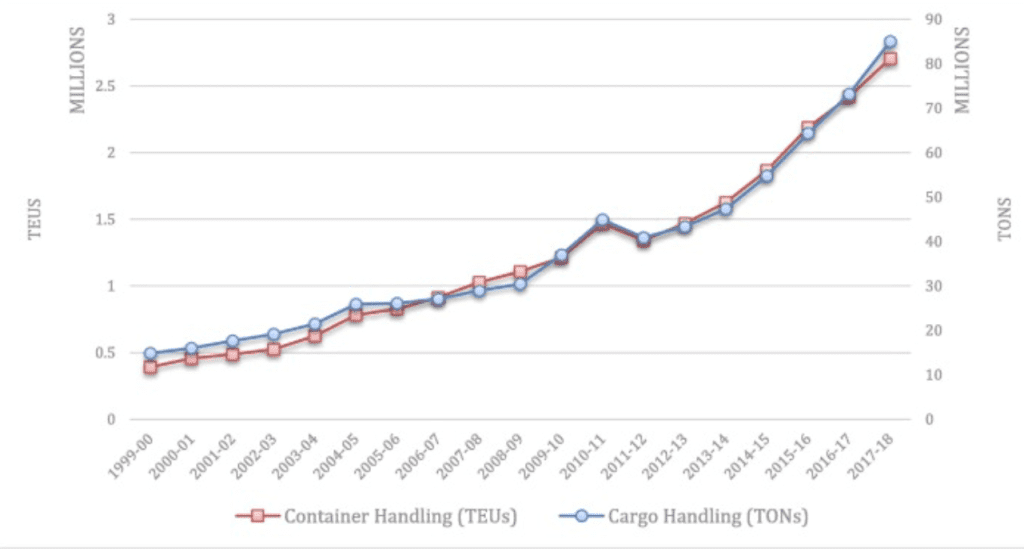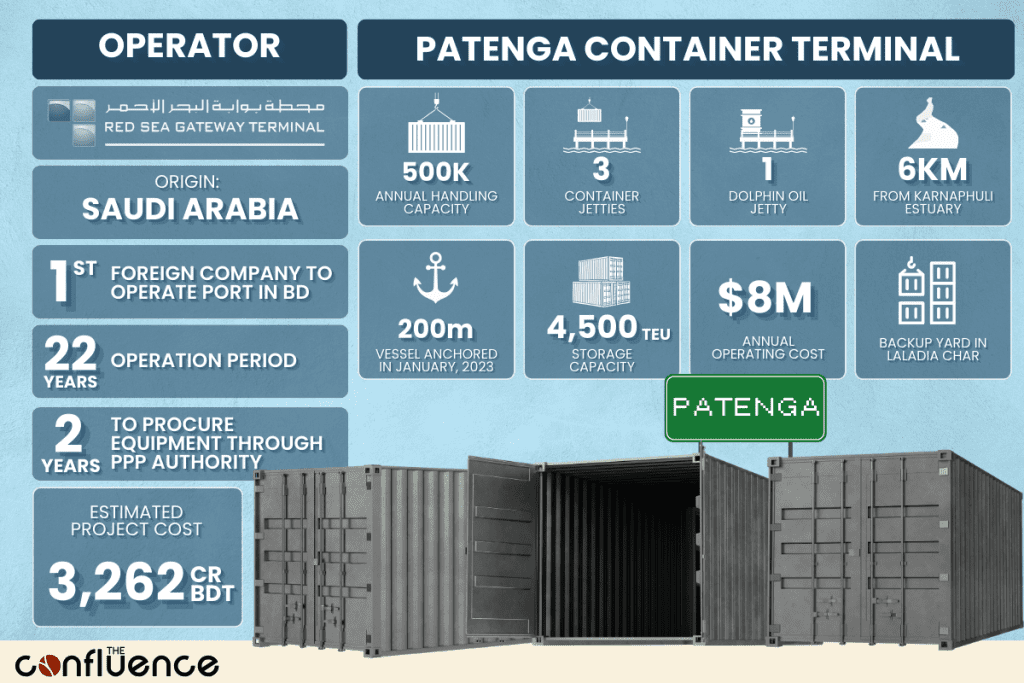One and a half years after the completion of construction, Prime Minister of Bangladesh formally inaugurated the Patenga Container Terminal (PCT) at the Chattogram Port, upgrading Chattogram Port’s capacity.
The new container terminal or the PCT, houses three jetties and an annual capacity to handle 500,000 TEUs of containers. However, its full operation hinges on the appointment of a foreign operator and the subsequent installation of heavy container handling equipment.
Chattogram Port’s Contribution
Chattogram Port handles more than 92% of the total sea related trade of the country. It covers container cargo, dry bulk and break bulk. The port is operated by the Chattogram Port Authority (CPA) which is under the administrative control of the Ministry of Shipping.

As the main seaport for Bangladesh, Chattogram Port has seen a continuous growth of cargo volume reflecting the wider economic growth of Bangladesh. lt manages 92% of all imports and exports, and 98 % of all containerized trade of Bangladesh. The total port throughout flourished at a rate above 8% in the last decade while containerized traffic grew at a rate of 11%. Container handling in Chattogram is expected to grow by 10.7 million TEUs by 2043. Considering the role of Chattogram Port in the external trade of the country and its growth projections, significant investment is required in increasing its capacity and improving efficiency.
Chattogram port in numbers
0
%
of Bangladesh’s Trade through Chattogram
0
%
Annual Growth of Container Traffic
0
M
TEUs Projected Container Traffic by 2043
Thus, considering the situation Bangladesh decided to develop Patenga Container Terminal Project as an important project to sustain increasing container growth.
Container Storage, Handling and Delivery of Chattogram Port Yards
Figures in TEU (Source: via TBS)
No Data Found
The Construction phase of PCT has been completed by Chattogram Port’s self finance.
Construction of PCT has been completed by CPA along with supply of navigational equipment such as Tug Boat, Pilot Boat, Speed Boat etc. The operational equipment like container & cargo handling has been supplied by the Global Operator including their replacements.
The Call for Full Operation
0
TEUs Overall Annual Handling Capacity
The Patenga Container Terminal (PCT) boasts the capability to manage approximately 500,000 TEU containers annually. Additionally, a contiguous 16-acre expanse adjacent to the Rubi Cement Factory acts as the contingency yard, elevating the overall handling capacity to an estimated 700,000-750,000 TEUs annually.
0
%
Annual Escalation of Container Handling Capacity
This innovative terminal is anticipated to contribute to an annual escalation of roughly 17 percent in the port’s container handling capability. It is poised to diminish vessel turnaround durations at the outer anchorage of the port, accommodating vessels with a draft of 10.5 meters and a length extending up to 190 meters, in contrast to the current jetties limited to a maximum draft of 10 meters.
Handling Larger Ships
Maximum draft size handled : increased from 10 metres to 10.5 metres
The vessels berthed at the PCT are positioned advantageously, facilitating expedited loading and unloading of containers due to its closer proximity to the Karnaphuli estuary compared to existing port jetties.
Four Jetties
Three container jetties and one solitary dolphin oil jetty
As delineated by the Chattogram port, the Patenga container terminal encompasses three container jetties and a solitary dolphin oil jetty, enabling the concurrent docking of three container ships and one oil tanker.
Decreased Cruise Distance
From 14 km to 6m
To access the primary jetty of Chattogram Port, ships navigate a river course spanning approximately 14 kilometers from the mouth of the River Karnaphuli. Interestingly, the distance from the Patenga container terminal to the Karnaphuli estuary is merely six kilometers.
Faster Loading and Unloading
Due to proximity
Port users and businesses stress the urgency of making the terminal fully operational to maximize its benefits. Proximity to the Karnaphuli estuary promises faster loading and unloading of containers compared to existing port jetties, emphasizing the economic advantages awaiting implementation.
Nominating the Operator
The government has nominated the Saudi Arabia-owned Red Sea Gateway Terminal International (RSGTI) to operate the terminal. However, the finalization of the appointment agreement is still pending, causing delays that stakeholders find concerning.
The construction of this fully equipped terminal is intended to enhance the port’s capacity in order to face future challenges. Remarkably, this is marked the first time that a foreign firm is appointed to operate a port terminal in the country. The appointment of the operator, is under a government-to-government framework facilitated by the Private Public Partnership (PPP) Authority.
Reduced Cost
From BDT 1868.28 Crore to BDT 1229 Crore
The journey from project approval in June 2017 to completion saw revisions and extensions. Initially set for completion in December 2019, the revised plan extended the timeline to June 2022. The construction cost, initially estimated at Tk 1,868.28 crore, was reduced to Tk 1,229 crore under a public-private partnership (PPP) model. This is one of the very few examples of cost reduction instead of overrun. The relation between PPP model and budget overrun is an avenue to inquire for more efficient project implementation in the future.
Foreign Engagement
The Red Sea Gateway Terminal’s confirmation as the operator marks a historic moment for Bangladesh, reflecting the growing confidence of foreign firms in the country’s future growth prospects. The engagement with a foreign company to operate a port is a first in Bangladesh’s history.
Masterplan Unveiling
Simultaneously, the prime minister unveiled the cover of the masterplan for the Bay Terminal, a mega extension project. This move underscores the continuous expansion and development of Chattogram Port to meet future demands.
Agreement Expectations
0
Years
RSGT Confirmed as the Operator
Expectations are high as the Red Sea Gateway Terminal (RSGT) is confirmed as the operator for 22 years. The anticipated agreement between the Chattogram Port Authority (CPA) and RSGT is expected to be signed within the coming months, marking a crucial step in the operationalization process.
Procurement Process
The Public Private Partnership Authority (PPP Authority) sheds light on the procurement process, indicating that equipment procurement and additions to the terminal will occur within two years of the 22-year contract. Red Sea Gateway’s commitment to modern machinery and technology bodes well for efficient port management.
Frustration Over Delays
Businesses express frustration over the considerable delay in launching the port’s operations despite being developed using CPA’s own financing. The call for expedited operational activities is driven by the potential cost and time reduction benefits the fully operational terminal could bring.
The Bangladesh Shipping Agents Association (BSAA) highlights the lost time due to delays in appointing a foreign operator, drawing parallels with the previously built New Mooring Container Terminal (NCT). Delays in operationalizing projects hinder the optimal benefit from vital infrastructure.
International Finance Corporation’s Role
The International Finance Corporation (IFC) played a vital role as the transaction adviser, preparing the investment proposal for Red Sea Gateway. The agency’s involvement underscores the strategic approach taken to appoint a foreign operator for Patenga container terminal.
Timeline and Agreement
The timeline for completing operational work depended on Red Sea Gateway, with the agreement expected to be signed within the next two months. The quicker the equipment becomes operational, the more beneficial it will be for both the company and the port.
Port’s Capacity Expansion
The Patenga Container Terminal, upon operation, is poised to increase Chattogram Port’s handling capacity by 17% annually. This expansion is a proactive move to meet future challenges and will be the first instance of a foreign firm operating a port terminal in Bangladesh.
Anticipating Growth and Efficiency
In conclusion, the inauguration of the Patenga Container Terminal represents a significant step in Bangladesh’s maritime development. While delays have posed challenges, the engagement of a foreign operator and the impending agreement signal a positive turn. The port’s expansion aligns with the nation’s growth prospects, promising increased efficiency and trade opportunities.
About the Author

Hamim Mubtasim is the Brand Manager at The Confluence. He is currently pursuing his undergraduate studies at the Institute of Business Administration, University of Dhaka. A business student by choice and marketing geek by passion, he aspires to manage big brands someday

1 comment
Really enjoyed reading your article.